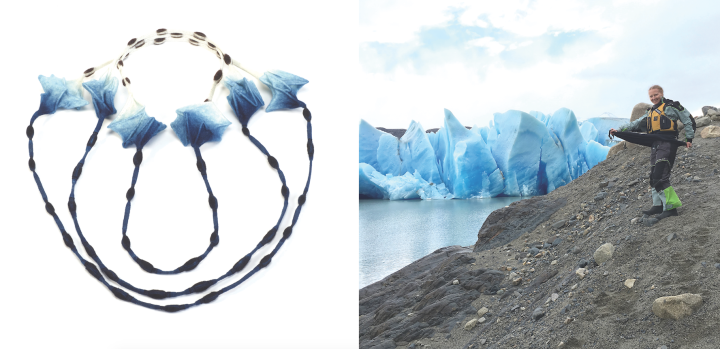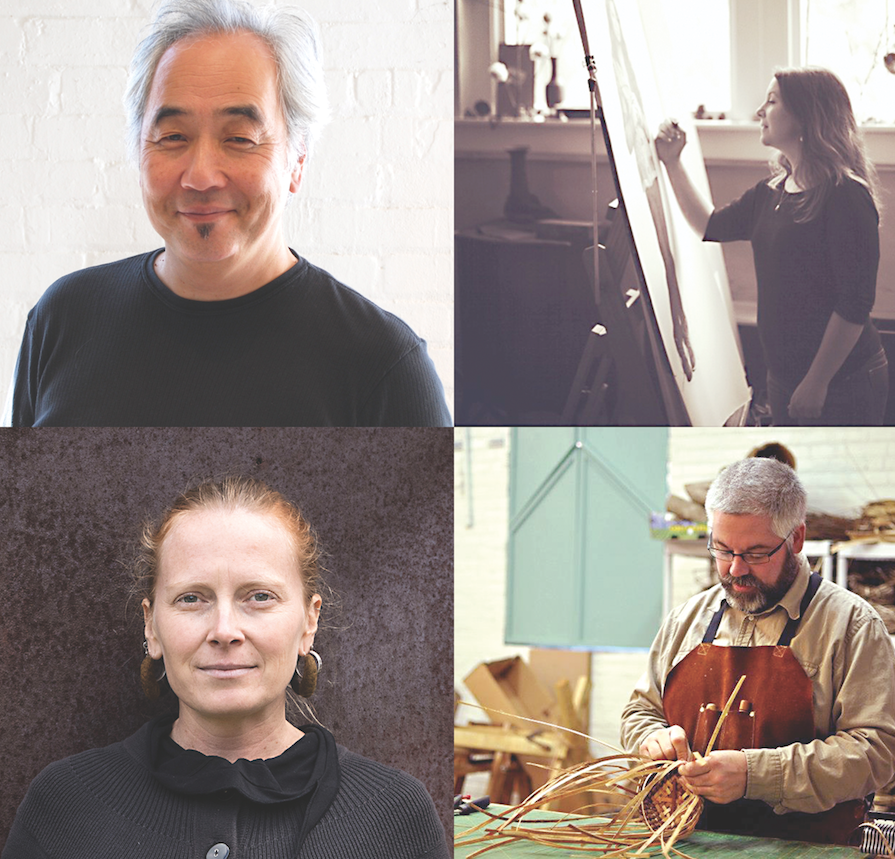Every year, several of Asheville’s local artists pack their suitcases and catch flights to teach their art and crafts abroad. From basketry to pottery and painting to fiber arts, these forms are discussed in seminars and taught in workshops all over the world. Germany, Scotland, Israel, Spain, New Zealand, Australia, Denmark and Norway are among the destinations.
For many, the initial opportunity to teach abroad comes as a reward for the act of creating. “My reputation just continued to spread from working domestically and showings and being in publications,” says fiber artist Lisa Klakulak. She taught at the Penland School of Crafts, which “has quite an international following,” she says. “Once you’re teaching there, they’re promoting you to the mailing list.”
Portrait painter and graphite artist Angela Cunningham echoes Klakulak’s thoughts on the importance of a strong network. Before arriving in Asheville in 2012, Cunningham taught at the Grand Central Academy in New York City. Many of her early teaching requests came from individuals, organizations and schools familiar with the program’s reputation and focus on classical realism.
This fall, Cunningham will spend three months in Belgium leading a course on the subject. She’ll run it as an atelier, a style of teaching that began in Europe during the Middle Ages and remained a popular approach until the 19th century. Cunningham describes the historic method as intentionally small in scale and specific in focus. “The master would teach their students, and then one of those students would teach another group of students and it would always be one instructor teaching one method,” she says.
For others, like basketry artisan Matt Tommey, international travel is self-initiated. Since 2010, he’s led gatherings that combine art and faith. “We started in Scotland,” he says. “A bunch of people from other European countries were there, and so I developed a relationship with a lady [from] Germany who invited me to come there, and then I met a bunch of people from the U.K., and so they invited me there. It’s the kind of thing where the more you do, the more you do.”
Potter Akira Satake agrees. “The longer you do it, usually more people will find you,” he says. Satake began leading pottery classes abroad with a trip to Israel in 2009. Over the years, the demand for his teaching has grown. For 2017, he has offers to instruct groups in Barcelona, Paris, Belgium, Scotland and Sweden. “I’m lucky to say I get enough [offers] to choose from,” he says.
The perks
“Traveling workshops pay better,” says Cunningham. “I can make three to four times more than I would staying here locally.” In addition, most organizations cover the artist’s travel and lodging. In some instances, stipends for food are also provided. Because of this, the main source of Cunningham’s income stems from her visits abroad.

Foreign locations have a way of inspiring many of these artists, as well. Klakulak notes the importance of traveling beyond the classroom. On a recent trip to Chile, she set aside time to visit the glaciers in southern Patagonia — a journey that is manifesting itself in her latest project. “I’m working on making stainless steel armatures that are really angular,” she says. “And then [I’m] skinning that with a really fine thin layer of felt and making these kind of glacier forms that I’m dyeing in indigo.”
Tommey, who uses kudzu, laurel branches and other locally foraged materials for his baskets, finds that his time in different countries opens his eyes to new possibilities. “When I was in Denmark and Poland several years ago, I saw people working with bark for the first time,” he says. During his latest trip to Australia, Tommey noticed the various types of grass and weaving methods that fellow artists used. “You see other landscapes, materials and aesthetics. … They all go inside your head and kind of marinate for awhile, if you will, and eventually come out of your work,” he says.
“It doesn’t matter what kind of country I’m in, I learn something,” Satake says. He points to the ever-expanding network he’s developed through teaching abroad. “I feel in a few years, probably, I’ll have nothing to worry about when it comes to going overseas and having a good place to stay.”
Learning on the fly
Of course, it isn’t all glorious glaciers and Tasmanian adventures. Suitcases must be packed, jet lag endured and security checks cleared. And no matter how exotic a place may be, home is still where the heart is. “More than two weeks is too long to be away from my family and business,” says Satake.
Material can be another hurdle. Schools and organizations often provide the artists with the items required to teach. This makes for lighter luggage but can create stress. “I’m sometimes working with natural materials I don’t normally have access to,” says Tommey. “So it’s kind of like I’m learning on the fly.”
Then there is the language barrier. While the artists note that many of their students speak English, or attend the class aware that it is being taught by an English speaker, translators are still at times required. This creates an undercurrent of conversation throughout the sessions.
In other instances, the initial contact and setup proves the greater obstacle. Email exchanges, says Klakulak, can get tricky. “We’re using Google Translate, and quite a bit gets lost or misconstrued in those conversations. … But honestly, once I get there and we’re having face-to-face interactions, and you don’t have to guess people’s tonality or intentions … it’s really quite an easy flow.”
Bringing it back home
Cunningham hopes to one day introduce the atelier approach to Asheville. “It’s nice for me to go out and see how big classic realism is [elsewhere],” she says, adding that while Asheville’s current focus is craft, the surrounding mountains and rivers seem ideal for lessons in landscape painting.
In May, Klakulak shared her experiences abroad at the annual Society of North American Goldsmiths. During the event, which took place in Asheville, Klakulak offered insight to fellow makers about the broad network that sustains her creative life.
For Satake, his return to Asheville is always welcome. “Everybody here is generous in showing what they do,” he says. “The community of artists is very nice.”
Tommey agrees. “I always say no matter where I travel in the world, I look forward to coming back to Asheville,” he says. “We’re such a rich, creative community. For me, it’s informed my creative perspective.”
To learn more, visit akirasatake.com, angelacunninghamfineart.com, strongfelt.com and matttommey.com




I also teach abroad and do workshops in London, Italy, Greece and France. Next year we are booking Greece and France now. I teach mixed media painting with specialty of painting digitally and then transferring to all to canvas and acrylic paint and mediums. More information is available by contacting me direct and I can send the links. I also teach all over the United States and Canada. It’s a wonderful way to network.
I very much appreciated being included in this article. Thank you Thomas Calder and Mountain Express for covering this topic. The images in the online article of my work and the glacier shot were credited as courtesy of the artist, however, Steve Mann of Black Box Photography captured the piece “Fractured Compaction” & my guide from Big Foot Patagonia snapped the shot at Glacier Grey in Torres del Paine National Park. Again, appreciated.